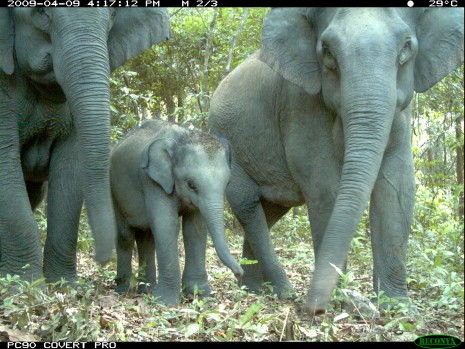In the dead of night, deep in the jungle, footsteps disturb the silence. A small device strapped to a tree is alerted. The device is designed to trap Cambodia’s surviving wild animals—not for their skin or meat, but for their images, collected for research.
In a program supported by the World Wildlife Fund (WWF), rangers from the Ministry of Environment and Forestry Administration in the country’s remaining forests are collecting stunning images that reveal species still under threat from poaching, land concessions and illegal logging. The camera trap is a vital tool for researchers trying to document threatened populations of large mammals.
Mark Wright, eastern plains landscape manager for WWF in Cambodia, said that trained teams place the traps in parts of the forests—animal trails, salt-licks or water holes—in hope that rare species such as the Indochinese tiger and the giant ibis will wander in front of them.
“Before setting the camera trap, researchers have to understand the animal’s habitat and ecology to decide where and how high to place the camera trap. So, for example, does the animal prefer shady paths or open forest; does it move along the ground or prefer to stay in the trees?”
The information garnered from the traps is used, in combination from testimony of rangers in the forests, “to track animal population changes and the health of the forest,” he said.
Many of the traps, which use infrared beams to detect movement and heat, triggering the camera to take a photograph, are placed at water holes, known as trapeang, which literally means pond in English.
“The cameras located at trapeang have allowed us to understand which species use these waterholes during the height of the dry season, when water can be limited, and thus give information on how to manage the protected areas for threatened species such as banteng, Eld’s deer and giant ibis,” he said.
He said the traps were also being used to “record elusive wild water buffalo in Mondolkiri Protected Forest, the only known site for the endangered ancestor of domestic buffalo in Indochina.”
Using camera traps in the forests—in isolated areas where loggers and poachers roam—is not trouble free, however.
“Camera traps will also record images of people carrying out illegal activities, if they pass in front of the camera,” Mr. Wright said.
“The result is that the cameras are often destroyed or stolen by these people who fear the photos will be used to incriminate them. This seriously damages the research effort as well as adding to the costs of the research because these camera traps are expensive to replace.”
A review of data produced by camera traps in Cambodia between 1999 and 2007, published in the Cambodian Journal of Natural History last year, recorded images of 28 globally threatened species.
The images include just five shots of tigers—possibly more than one of the same individual—in Eastern provinces, including the last confirmed sighting of a tiger in Cambodia, taken in Mondolkiri in November 2007. Since then, and despite targeted efforts, no tigers have been documented, according to the study, the lead author of which was WWF monitoring advisor Thomas Gray.
The Mondolkiri Protected Forest is also one of only two places in Asia that support three rare wild cattle species—banteng, gaur and wild water buffalo.
During the eight-year period, camera traps captured 63 images of leopards in five different sites around the country, and scientists estimate that there are almost four leopards per 100 square kilometers in the core of the Mondolkiri Protected Forest.
However, the study concluded, “the leopard is probably now very rare away from the cores of large, better managed protected areas in Cambodia.”
Similar negative outlooks are envisioned in the study for many of the species captured by the traps, as deforestation and agricultural projects on an industrial scale have broken up habitats into smaller areas incapable of sustaining populations.
The paper also notes that only four of the nine areas monitored were inside forests officially labeled “protected” by the government.
“More worrying, only two of these protected areas [Phnom Prich Wildlife Sanctuary and Mondolkiri Protected Forest] currently receive relatively effective protection by Cambodian government conservation agencies…with financial and technical support from international NGOs….
“Consequently the state of forest cover and remaining biodiversity at [the other] sites is unknown, but is likely to be greatly reduced since the data…was collected.”




